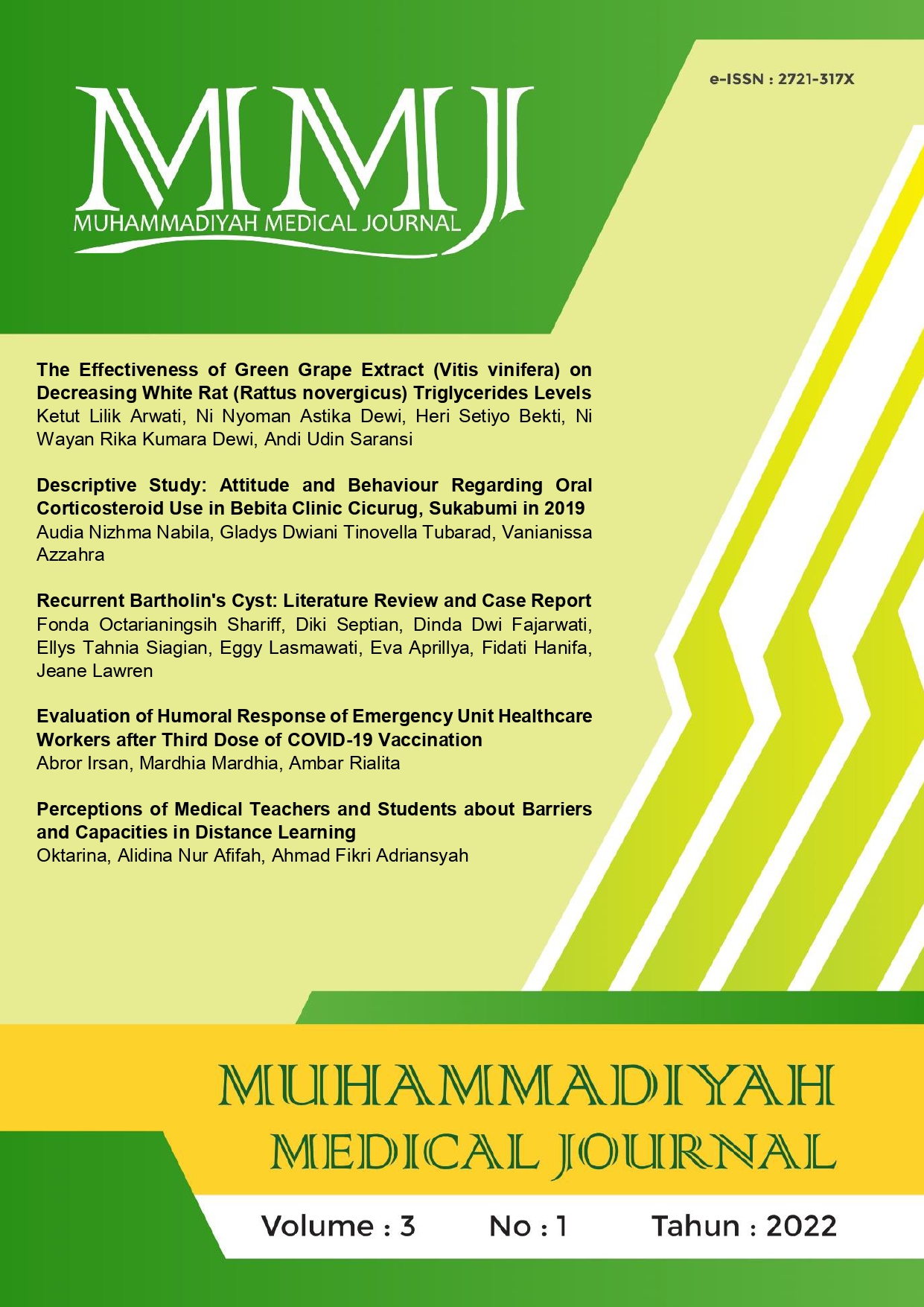Perceptions of Medical Teachers and Students about Barriers and Capacities in Distance Learning
DOI:
https://doi.org/10.24853/mmj.3.1.33-39Keywords:
components in distance learning, distance learning, technical constraints of distance learningAbstract
Background: Currently, distance learning is booming and requires adaptation from students, teachers, and faculty. Identifying constraints is essential as inputs for faculty development. Purposes: to identify teacher and medical student perceptions of barriers and capacity in distance learning. Methods: This research was conducted using a cross-sectional survey of 42 medical teachers and 613 students Faculty Medicine and Health, Universitas Muhammadiyah Jakarta students. It utilized secondary data from the Quality Assurance Unit in October 2020. Six variables were studied in this research, i.e., technical constraints of distance learning, teachers' perceptions of the essential components in distance learning, student self-perceptions, teachers' and students' perceptions of web conference effectiveness, and teachers' self-perceptions and students' satisfaction. Results: The top 5 technical constraints of distance learning complained were signal interference, internet data plan, limited e-literatures, and lack of communication with the faculty. According to the teachers, the essential components were faculty commitment (90%), regulation (85%), technical support (79%), course management, and teaching-learning guidelines (77%). Most students experience learning difficulties during distance learning. However, only 45% of students felt their independent learning method is effective. Teachers and students agreed that web conferencing is ineffective for learning clinical skills but disagreed on cognitive knowledge. 74% of teachers stated that the presentation was engaging. Meanwhile, more than 25% of students were dissatisfied. Conclusion: The top 4 technical constraints were signal interference, internet data plan, limited e-literatures, and lack of communication with the faculty. The important components of distance learning were faculty commitment (90%), 83% of students experienced learning difficulties during distance learning.References
World Health Organization (WHO). Novel Coronavirus [Internet]. 2019. Available from: who.int/ emergencies/disease/novel-coronavirus-2019
UNESCO Organization. UNESCO [Internet]. 2022 [cited 2022 Apr 14]. Available from: https://unesco. org/en
Basilaia G, Kvavadze D. Transition to Online Education in Schools during a SARS-CoV-2 Coronavirus ( COVID-19 ) Pandemic in Georgia. 2020;5(4).
Duraku ZH, Hoxha L. The impact of COVID-19 on education and on the well- being of teachers , parents , and students : Challenges related to remote (online) learning and opportunities for advancing the quality of education. In 2020.
Dutta S, Smita MK. The Impact of COVID-19 Pandemic on Tertiary Education in Bangladesh: Students’ Perspectives. Open J Soc Sci. 2020;08(09):53–68.
Hasan N, Bao Y. Impact of “e-Learning crack-up” perception on psychological distress among college students during COVID-19 pandemic: A mediating role of “fear of academic year loss.” Child Youth Serv Rev [Internet]. 2020;118 (August):105355. Available from: https://doi.org/10.1016/j.childyouth.2020.105355
Tubarad GDT, Wiratmoko MR, Aulia SN, Prameswari SC, Pramana S. An Overview of Medical Students’ Psychological in The Process of Distance Learning on Pandemic COVID-19. Muhammadiyah Med J. 2021;2 (2):62.
Akhtarul Islam M, Barna SD, Raihan H, Nafiul Alam Khan M, Tanvir Hossain M. Depression and anxiety among university students during the COVID-19 pandemic in Bangladesh: A web-based cross-sectional survey. PLoS One [Internet]. 2020;15(8 August):1–12. Available from: http://dx.doi. org/10.1371/journal.pone.0238162
Salameh MA, Boyajian SD, Odeh HN, Amaireh EA, Funjan KI, Al-Shatanawi TN. Increased incidence of musculoskeletal pain in medical students during distance learning necessitated by the COVID-19 pandemic. Clin Anat. 2022;35(4): 529–36.
Kitiş A, Büker N, Ünal A, Şavkin R. Effects of musculoskeletal system problems on quality of life and depression in students preparing for university entrance exam. Korean J Pain. 2017;30(3):192–6.
Sundarasen S, Chinna K, Kamaludin K, Nurunnabi M, Baloch GM, Khoshaim HB, et al. Psychological impact of covid-19 and lockdown among university students in malaysia: Implications and policy recommendations. Int J Environ Res Public Health. 2020;17(17):1–13.
Lassoued Z, Alhendawi M, Bashitialshaaer R. An exploratory study of the obstacles for achieving quality in distance learning during the covid-19 pandemic. Educ Sci. 2020;10(9):1–13.
Galusha J. Barriers to Learning in Distance Education. An Electron J 21st century [Internet]. 1997;5(3/4):6–14. Available from: http://files.eric.ed.gov/fulltext/ED416377.pdf
Joshi A, Vinay M, Bhaskar P. Impact of coronavirus pandemic on the Indian education sector: perspectives of teachers on online teaching and assessments. Interact Technol Smart Educ [Internet]. 2021 Jan 1;18(2):205–26. Available from: https://doi.org/10.1108/ITSE-06-2020-0087
Hebebci MT, Bertiz Y, Alan S. Investigation of Views of Students and Teachers on Distance Education Practices during the Coronavirus (COVID-19) Pandemic. Int J Technol Educ Sci. 2020;4(4):267–82.
Love ML, Simpson LA, Golloher A, Gadus B, Dorwin J. Professional Development to Increase Teacher Capacity for the Use of New Technologies. Interv Sch Clin [Internet]. 2020 Apr 27;56(2):115–8. Available from: https://doi.org/ 10.1177/1053451220914886
The Organization for Economic Cooperation and Development. Position Paper: The Future of Education and Skills 2030.
Engelhart M. Building Teacher Capacity for Blended Learning Environments. In: Society for Information Technology & Teacher Education International Conference. Washington DC, United States: Association for the Advancement of Computing in Education (AACE); 2018.
The Organization for Economic Cooperation and Development. Strengthening online learning when schools are closed - The role of families and teachers in supporting students during the COVID-19 crisis [Internet]. Oecd. 2020. Available from: https://read.oecd-ilibrary.org/view/?ref=136_136615-o13x4bkowa&title=Strengthening-online-learning-when-schools-are-closed
Chang B. Reflection in learning. Online Learn J. 2019;23(1):95–110.
Ringmar GC. Designing for students’ self-reflection in online learning settings: A mixed method study. KTH Royal Institute of Technology; 2021.
Kahn P, Everington L, Kelm K, Reid I, Watkins F. Understanding student engagement in online learning environments: the role of reflexivity. Educ Technol Res Dev. 2017;65(1):203–18.
Downloads
Published
Issue
Section
License
Authors who publish in the Muhammadiyah Medical Journal agree to the following terms:
- Authors retain copyright and grant Muhammadiyah Medical Journal right of first publication with the work simultaneously licensed under a Creative Commons Attribution Licence that allows others to adapt (remix, transform, and build) upon the work non-commercially with an acknowledgement of the work's authorship and initial publication in Muhammadiyah Medical Journal.
- Authors are permitted to share (copy and redistribute) the journal's published version of the work non-commercially (e.g., post it to an institutional repository or publish it in a book), with an acknowledgement of its initial publication in Muhammadiyah Medical Journal.

